Difference between revisions of "AY1516 T2 Team CommuteThere Project Further Analysis"
| Line 149: | Line 149: | ||
The distance from bus stops to the nearby schools are calculated using Hub Distance function from MMQGIS. From the Hub Distance distribution, on average, bus stops are 262 m away from schools and 75% of the bus stops are within 300m from schools. As research has shown that people,on average,are willing to walk up till 400m(Walker, 2011), the bus stops that students alighted at to go to school are moderately well located from school. | The distance from bus stops to the nearby schools are calculated using Hub Distance function from MMQGIS. From the Hub Distance distribution, on average, bus stops are 262 m away from schools and 75% of the bus stops are within 300m from schools. As research has shown that people,on average,are willing to walk up till 400m(Walker, 2011), the bus stops that students alighted at to go to school are moderately well located from school. | ||
{|style="margin: auto;" | {|style="margin: auto;" | ||
| − | |[[File:Team_WalkThere_BusStops.png| | + | |[[File:Team_WalkThere_BusStops.png|600px]] |
|} | |} | ||
From OSM map, the bus stops that are more than 400m away from the schools are highlighted in yellow. Students who alighted near the Tampines Bus Interchange are assumed to be traveling out of Tampines New Town by transiting to MRT or other bus services. Thus, the bus stops around this area would not be of a concern to the planners. | From OSM map, the bus stops that are more than 400m away from the schools are highlighted in yellow. Students who alighted near the Tampines Bus Interchange are assumed to be traveling out of Tampines New Town by transiting to MRT or other bus services. Thus, the bus stops around this area would not be of a concern to the planners. | ||
Revision as of 23:34, 15 April 2016
Contents
Adult
Elderly
Student
1. Distance Traveled for at Least 4 Trips Made During Morning Peak
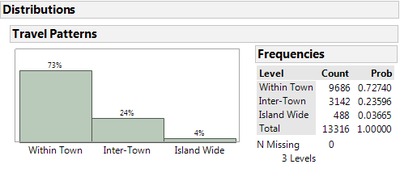
|
As can be seen from the bar chart above, most of the destinations are within Tampines Area and the nearby new town. 73% of the students who made at least 4 trips during that week are within Tampines New Town, whereas 24% of them travel to nearby new towns such as Bedok and 4% of them travel to other places that are not of close proximity to Tampines. This means that students who made at least 4 trips during that week is likely to travel short distance to school during morning peak hour.
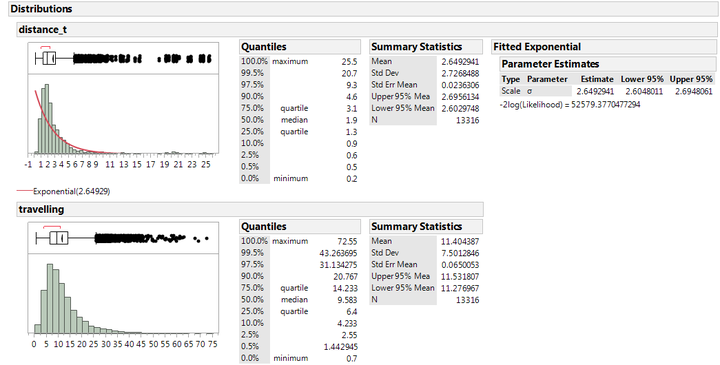
|
This can be further supported by the distribution above on the distance travelled for students who made at least 4 trips during that week. The distribution is right skewed with a distance decay index of 2.64. With reference to the overall distance decay index of 3.6 for students(as seen in Initial Analysis), students are less willing to travel a longer distance during morning peak period. 50% of the trips are less than 2km which means that 50% of the trips are completed within 10 minutes. On average, students travel 2.64km on weekdays to school which took them about 12 minutes to reach their destination.
2. Multimodal Transportation Patterns
2.1 Revised Travel Patterns
As seen from Initial Analysis, Simei and Tampines are two of the popular destinations during morning peak hour made by students who made the same trips for at least 4 times during a week. This suggests that some students might actually use multi modes of transportation to get to their destination. Thus, we made use of MRT data to further analyse how the distributions for travel patterns will change if multi modal transportation is taken into consideration.
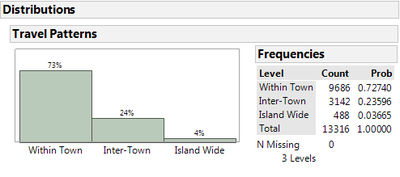 |
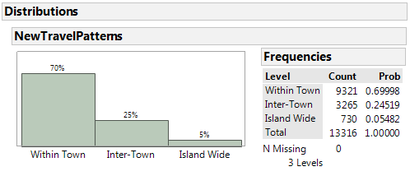
|
From the distribution above, The absolute count of within town trips has decreased from 9,686 to 9,516. On the other hand, absolute count for inter-town trips and island wide trips has increased from 3,142 to 3,222 and 488 to 579 respectively. However, the change in percentages are negligible and most of the trips made are still within Tampines New Town.
2.2 Transfers
As our multimodal transportation dataset consist of transfer made from (i) MRT/LRT to a bus service and (ii) bus service to MRT/LRT, we would like to help our sponsor to understand the efficiency of the current transportation system by looking at the amount of effort that the students have to make in order to transfer from one mode of transportation to another. Our group will be analysing the transfer interval of (MRT →Bus) and (Bus →MRT).
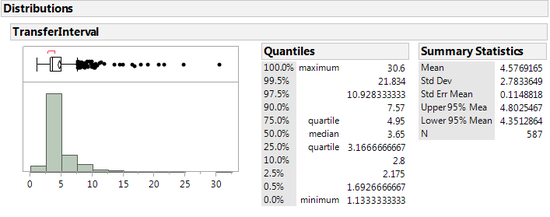
|
The distribution shows the overall transfer interval of students. On average, students took about 5 minutes to transfer from one mode of transportation to another mode of transportation with 90% of the students transiting within 10 minutes. Our group feels that this is a fairly reasonable transfer interval which indicates that our current transportation system is quite efficient.
2.2.1 MRT/LRT to Bus Service
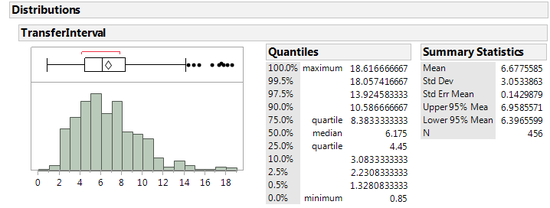
|
The distribution shows the transfer interval of students transferring from MRT to bus. On average, students took about 7 minutes to transfer with 90% of the students transiting within 10 minutes. This means that the bus interchange is of close proximity to the MRT. As the time interval takes into account the time taken for students to walk to the bus interchange and bus waiting time, we are able to deduce that the bus frequency in Tampines is quite high during morning peak period which lead to short bus waiting time. This enables students to be able to transfer from MRT to bus within 7 minutes.
2.2.2 Bus Service to MRT/LRT
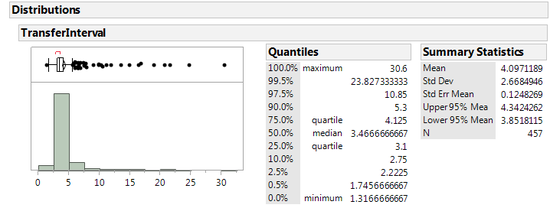
|
The distribution shows the transfer interval of students transferring from bus to MRT. On average, students took about 4 minutes to transfer with 90% of the students transiting within 5 minutes. This means that the MRT is of close proximity to the bus interchange which shows that minimum effort is required for students to transfer from Bus to MRT.
Comparing the transfer intervals of (i) and (ii), the transfer interval will be longer if the student is transferring from MRT to bus as compared to bus to MRT.
2.3 Least Cost Walk Path Analysis
2.3.1 Relationship Between Walking and Bus Transportation
Besides bus and MRT, walking is also a mode of transportation. The Singapore government recently introduced “Car Free Sunday SG” as part of their initiatives to shift Singapore towards a car-lite future so as to be more sustainable in the long run (Lee, 2016). Thus, we would like to help our sponsor to understand the relationship between walking and bus transportation.
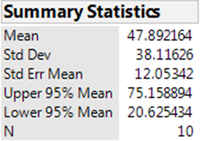
|
Studies have shown that on average, people are willing to walk up till 400m (Walker, 2011). Furthermore, our group assumes that for the same destination,buses tend to travel a longer distance as compared to walking. Thus, this analysis will only consists of students who made at least 4 trips during the week and the distance traveled is less than or equal to 1km.
A comparison between 10 of the least cost paths constructed using the Traditional Method and using the Euclidean Distance method shows that on average, the Euclidean Distance method will underestimate the distance travelled by about 125m. [Error bound: 47.89+ 2* 38 ≈ 125m ]As our group will be using the Euclidean Distance method due to time constraint and therefore, 125m will be added to the distance calculated using the Euclidean Distance method.
A study conducted by a student in Portland State university shows that the average walking speed of young male and female is 4.96 and 4.73 feet per second respectively. Thus, we will made use of the average of these two speed which is 4.85 foot per second or 88.6 meter per minute for our analysis (Carey, 2005).
A report released by SBS transit shows that the waiting time for bus services during peak period is on average 15 mins (SBS Transit,n.d). Since there are several initiatives,such as the bus service enhancement programme, to improve the bus service level in singapore, an average of 10mins waiting time will be used instead of 15 mins.
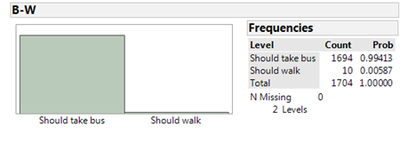
|
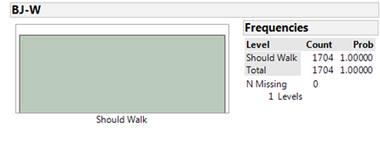
|
| Walking Time vs Bus Travel Time(excluding bus waiting time) | Walking Time vs Bus Travel Time(including bus waiting time) |
By comparing walking time and bus travel time(excluding bus waiting time), most of the students will prefer to take the bus since it is faster than walking as represented by “Should take bus”. Although there is a minority of students who might prefer to walk since walking time is shorter than bus travel time (i.e “should walk”), upon further analysis, the difference between the walking time and bus travel time is negligible. Thus, most of the students will prefer to take the bus.
By comparing walking time and bus travel time(including bus waiting time of 10mins), most of the students should prefer to walk since walking time is shorter than bus travel time. This means that if the bus frequency is high during morning peak period, this will reduce bus waiting time which will encourage students to take the bus instead of walking. If the bus frequency is low, the increased bus waiting time will discourage students to take the bus and they will choose to walk to school instead.
From our group’s findings, it seems to suggest that the bus frequency within Tampines area during morning peak hour is quite high and therefore the reduction in bus waiting time during morning peak hour discourage students from walking to school.
2.3.2 Recommendations
Based on our analysis, it seems to suggests that in order to encourage utilitarian walking among the students, the relevant bus companies would have to reduce the frequency of their buses during morning peak period as the short bus waiting time due to high bus frequency will discourage students to walk. However, our group recognise that it is not a politically wise decision to reduce the bus frequency during peak period in order to encourage students to walk as it might lead to public outcry since the other popular groups(i.e elderly and adult) are affected as well. By taking into account the impact of high bus service levels in Singapore on walkability of students, a multi-pronged approach is required to bring about behavioural changes among the students. There is unprecedented potential for cross-sector collaboration to work towards encouraging utilitarian walking among the students.
For example, the Ministry of Education (MOE) can partner with the Singapore Health Promotion Board to launch behavioural change campaigns in schools to encourage students,especially those who live near the school, to walk to school instead of taking a bus in a bid to ease the congestion problem during morning peak hour. MOE can also collaborate with the Urban Redevelopment Authority(URA) to hold discussion forums with the students in order for planners to understand how they can further improve current urban design policy in order to encourage students who live near the neighbourhood to walk to school.
3. Bus Stops Access Potential
3.1 Bus Stops Proximity to Schools
As we have established that students,who made at least 4 trips in a week, are traveling to school during morning peak hour and most of the trips made are within Tampines New Town, it is important for our sponsor to understand if the current transportation system meet the needs of these students by assessing if the bus stops that these students alight at are of close proximity to the school
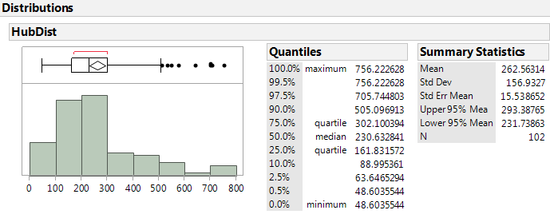
|
The distance from bus stops to the nearby schools are calculated using Hub Distance function from MMQGIS. From the Hub Distance distribution, on average, bus stops are 262 m away from schools and 75% of the bus stops are within 300m from schools. As research has shown that people,on average,are willing to walk up till 400m(Walker, 2011), the bus stops that students alighted at to go to school are moderately well located from school.
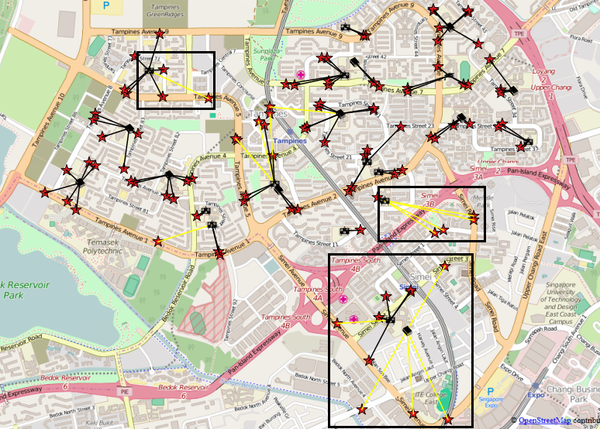
|
From OSM map, the bus stops that are more than 400m away from the schools are highlighted in yellow. Students who alighted near the Tampines Bus Interchange are assumed to be traveling out of Tampines New Town by transiting to MRT or other bus services. Thus, the bus stops around this area would not be of a concern to the planners.
Students who alighted near Temasek Polytechnic are assumed to be poly students as if they are primary school students who are going to the primary school that is assigned by QGIS, they would have alighted at the previous bus stop instead of the current one. Thus, this particular bus stop that is highlighted is not of a concern.
Therefore, the bus stops that are more than 400m away from the schools and are deemed to have low accessibility to schools are shown in the boxes.
3.2 Recommendations
Based on our earlier findings, bus stops that are more than 400m away from the school would require further analysis to understand the purpose of the students who alighted at these bus stops and whether they are actually going to the schools nearby. However, this is beyond the scope of our project. Assuming that the students are indeed going to the schools nearby, planners would have to look at the number of students affected and consider if they should relocate these bus stops nearer to the schools in order to better serve the needs of these students.
